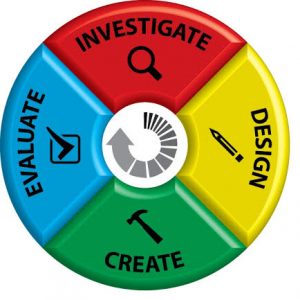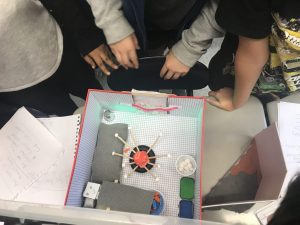 At Gaynor, the Design Cycle is incorporated throughout the curriculum for students and also used by faculty to find creative solutions to problems in their classrooms, which will be detailed in an upcoming web story. The four stages of the Design Cycle are, “investigate, design, create, and evaluate.” They are typically conceptualized in a graphic similar to the one on the left, but it is important to note that it is not necessary to move through the process in a clockwise manner or only one time. According to Matt LeWinter, Gaynor’s Director of Technology, “When students are in the evaluation process, they decide if they have reached the result they desired. If not, they take their results, return to one of the previous steps, and perhaps start over again.” The Design Cycle promotes a design-oriented mindset and flexible thinking and can be applied to art, science, math, reading, and other subjects.
At Gaynor, the Design Cycle is incorporated throughout the curriculum for students and also used by faculty to find creative solutions to problems in their classrooms, which will be detailed in an upcoming web story. The four stages of the Design Cycle are, “investigate, design, create, and evaluate.” They are typically conceptualized in a graphic similar to the one on the left, but it is important to note that it is not necessary to move through the process in a clockwise manner or only one time. According to Matt LeWinter, Gaynor’s Director of Technology, “When students are in the evaluation process, they decide if they have reached the result they desired. If not, they take their results, return to one of the previous steps, and perhaps start over again.” The Design Cycle promotes a design-oriented mindset and flexible thinking and can be applied to art, science, math, reading, and other subjects.
In Jane Moskowitz’s and Sydney Strauss’ Silver Cluster class, students have spent the last several weeks enmeshed in the cycle, applying it to their cluster-wide read aloud, The Wild Robot. Ms. Moskowitz was contemplating how to bring the story to life for her students, and the design cycle was a fantastic way to play to her students’ creative strengths as well as create a memorable hands-on project to foster comprehension.
According to Ms. Moskowitz, the novel revolves around a robot protagonist, Roz, who ends up mothering a baby goose. Roz, who was stranded on an island, is tasked with building a home for her and her gosling, that she refers to as a “nest.” She sets parameters for this nest and enlists the help of some beavers to build a stable, comfortable, and spacious house. Ms. Moskowitz tasked her class with the same task; to use the same parameters and build their own version of a nest suitable for the characters.

The class was broken up into smaller groups, which then spent time in the “investigate” phase, where they figured out the standards they needed to adhere to prior to moving on to the design phase. Their carefully-drawn plans were then checked by a teacher, who assisted them in figuring out if they needed to return to the design phase and make adjustments or proceed to the “create” phase.
“The goals of this project were multifaceted,” said Moskowitz. “First and foremost, I wanted to provide students with an opportunity to feel successful and take pride in their work. Second, my hope was to foster effective student collaboration and create a platform through which students could hone executive functioning skills. And last, I aspired to find an avenue through which students could truly engage in the literature, by creating for them an experiential task.”
It’s safe to say, mission accomplished. Ms. Moskowitz and Ms. Strauss said of the project, “It was incredible to watch our students’ creativity spark and observe them as they collaborated and worked together.”
